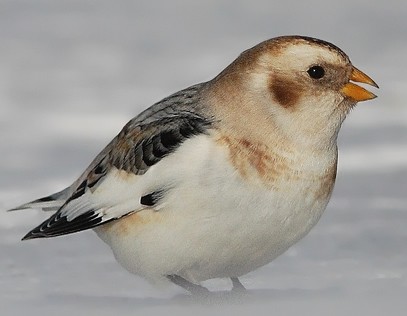Snow Bunting
A species of Snow and Mckay'S Buntings Scientific name : Plectrophenax nivalis Genus : Snow and Mckay'S Buntings
Snow Bunting, A species of Snow and Mckay'S Buntings
Botanical name: Plectrophenax nivalis
Genus: Snow and Mckay'S Buntings
Description
The snow bunting (Plectrophenax nivalis) is a passerine bird in the family Calcariidae. It is an Arctic specialist, with a circumpolar Arctic breeding range throughout the northern hemisphere. There are small isolated populations on a few high mountain tops south of the Arctic region, including the Cairngorms in central Scotland and the Saint Elias Mountains on the southern Alaska-Yukon border, as well as the Cape Breton Highlands. The snow bunting is the most northerly recorded passerine in the world. 
Size
16 - 18 cm
Colors
Brown
Gray
White
Life Expectancy
8 years
Nest Placement
Ground
Clutch Size
2 - 7 eggs
Incubation Period
1 brood
Number of Broods
10 - 15 days
Nestling Period
9 - 15 days
Feeding Habits
Snow Bunting consume seeds from a variety of plants and weeds, in addition to insects and spiders. They feed on ground or aerial prey and forage in snow for seeds in colder months. During summer, seeds and invertebrates dominate their diet, while nestlings are exclusively fed invertebrates.
Habitat
During breeding, snow Bunting inhabit the inhospitable Arctic tundra, opting for rocky, sparse landscapes ideal for nesting and young protection. High altitudes and cold climates featuring wet sedge meadows, dryas, and lichen-rich vegetation define their summer locales. Come winter, snow Bunting transition to temperate open areas like agricultural fields and coastal zones, scavenging for seeds on the ground.
Nest Behavior
Females of snow Bunting exhibit reuse of old nests, refreshing them annually. They synchronize nest building with the harsh climate, followed by a relatively fixed egg-laying routine and share parental responsibilities.
Nest Characteristics
Snow Bunting typically construct their nest in secluded rock crevices or holes, shielding it from external view. They utilize moss, grass, rootlets, as well as fur and feathers, to create a sturdy open cup.
Dite type
Granivorous
People often ask
Migration Overview
The snow buntings migrate to the Arctic to reproduce and they are the first migrant species that arrives to these territories. They must gain at least 30% of body mass before migration. The males will arrive first at the beginning of April, when temperature could reach -30 degrees Celsius. This early migration could be explained by the fact that this species is highly territorial and the quality of the nesting area is crucial to their reproductive success. Females will arrive four to six weeks later, when the snow starts to melt. They tend to migrate in small flocks and have an undulate flight at a moderate height. This passerine bird overwinters in northern temperate zones in open fields forming moving flocks. They will leave the Arctic at the middle and end of September, although some will start the migration at the beginning of November. The female leaves first and tends to winter in more southern territories than the male, while the juveniles will leave the Arctic even later than the adults. The migration of this bird is nocturnal and they are able to detect the geomagnetic field of the earth in order to guide themselves to their breeding and overwinter territory. The orientation of the snow bunting during migration is independent of any type of visual cue. Furthermore, studies have shown that only those individuals with adequate energy storage will be able to select seasonally appropriate directions during their migration. 
General Info
Feeding Habits
Bird food type
Bird Feeder Type

Ground

Platform
Sounds
Call
Recording location: United States
Call
Recording location: United States
Song
Recording location: United States
Song
Recording location: United States
Behavior
Snow Bunting exhibit a distinctive lifestyle adapted to cold habitats. These birds are often seen foraging on the ground, seeking seeds and insects with a preference for walking or running rather than flying. When spring arrives, snow Bunting perform a unique ritual using compacted snow to cleanse and subsequently expose their vivid plumage. Males notably precede females to the breeding territories to establish dominance, engaging in aggressive behaviors and aerial displays to ward off rivals and attract mates. They showcase a particularly spirited courtship involving steep ascents and strategic glides. Snow Bunting's social structure turns more communal in winter when they join in restless flocks, mirroring the shifting snow as they move in a leapfrogging manner across the terrain.
Distribution Area
This species is found in the high Arctic tundra of North America, Ellesmere Island, Iceland, higher mountains of Scotland, Norway, Russia, North Greenland, Siberia, Novaya Zemlya, and Franz Josef Land. During the winter, this bird migrates to the circumglobal northern temperate zone including the south of Canada, north of the United States, north of Germany, Poland, Ukraine, and east to central Asia.
Species Status
Not globally threatened.
Scientific Classification
Phylum
Chordates Class
Birds Order
Perching birds Family
Longspurs and snow buntings Species
Snow Bunting 